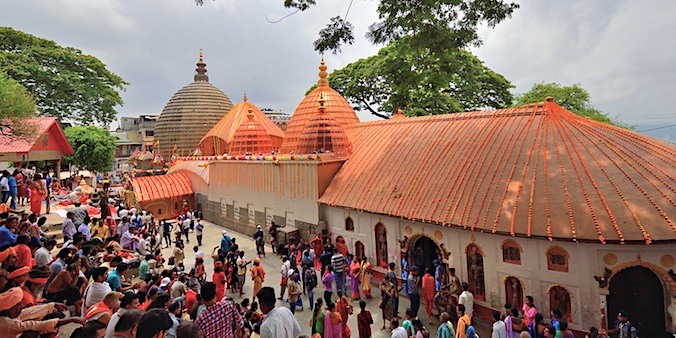Highlights of North-east India
Tour - 12 days
About ASSAM and Nagaland
Assam is the only state in north-east India that is almost entirely low lying. It consists largely of the flood plains of the Brahmaputra, one of the largest untamed rivers in the world. The climate is fantastic for rice cultivation, all kinds of tropical crops, bamboo cultivation and fish farming.
Assam is relatively densely populated. The legal part of the population consists of at least 35 million people on an area of 78,000 square kilometers (similar to Czechia, a bit smaller than Austria), the illegal part at least 5 million.
Read more…Read lessThe name Assam comes from the same origin as Siam, which means Thailand. The larger part of the population finds its roots far to the east, from where their ancestors, the Ahums, entered the area in the 13th century. For more than 600 years the Ahums upheld a kingdom in Assam. Especially in the last two centuries the Assamese culture, language and genetics have changed due to frequent immigration from India, Nepal and later Bangladesh.
Before the Ahums settled in the Brahmaputra Plain, other peoples already lived here. The most important of these are the Bodos, who now live mainly in the north and northwest of Assam (population about 1.5 million).
Nagaland is wedged between Assam in the west and Myanmar (Burma) in the east. It is about half as large as the Netherlands and, with around 2 million inhabitants, relatively thinly populated. Nagaland is quite mountainous, the highest mountain reaching 3840m (Mt. Saramati). But most of the state is between 500 and 2000m, and thus endowed with a climate in which virtually anything will grow. The main crops are rice (especially mountain rice), corn, millet, pulses, tobacco, oilseeds such as mustard, sugarcane, potato, and bamboo.
A significant part of the population still lives of shifting cultivation, whereby every so many years a new piece of forest is burnt down, tilled for a number of years till the soil is exhausted, and then left for another piece of land. The government is trying to discourage this highly unsustainable form of farming, and encourage alternatives, such as orange and pineapple cultivation.
Read more…Read lessThe people of Nagaland belong to the Burmese-Tibetan ‘race’, and originate probably from Tibet, perhaps with influx from Southeast Asia. They are believed to have settled around the year 1000 in present day Nagaland. Although he Nagas never had their own state, they were considered a culturally and geographically distinct entity by neighbouring countries.
One of the causes of this lack of statehood was the habit of the Naga tribes to continuously wage wars between them. In addition, the Nagas had the curious habit of head hunting. The heads and scalps were cherished as trophies and can still be seen in the villages. Contact with Christianity has eventually made them abandon the practice, but not before the early fifties. Today the war dances of he Nagas, performed at festivals, are a major draw for tourists.
There are 18 different tribes, each with its own distinct customs, dialect and clothing. But the Nagas are united in their cultural traditions and customs, religion – today, almost all Nagas are Christians – and the use of Nagamese – a lingua franca that is a mix of Naga and Assamese.
Region
Assam & Nagaland (India)
Best Time
Feb-April &
Nov-Dec
No. Of Days
12 days
Trip Character
Jeep tour
Sleeping Altitude
65 - 1400 m
Price
INR XXX/ $ XXX
ABOUT THIS TOUR
The Northeast of India is an immensely biodiverse and culturally rich area. It consists of seven states, each of them with different landscapes, people and culture. On this compact tour, we’ll show you some highlights of Northeast India, in two very different states, Assam and Nagaland.
From Delhi or Kolkata you fly to Dibrugarh, India’s easternmost city, situated on the banks of the Brahmaputra. Here, you’ll stay at a very atmospheric nineteenth century tea estate manager’s bungalow amidst lush and extensive tea plantations.
Traveling westwards, you’ll visit the ancient temple and palace remains of the Ahum empire and then board a ferry to Majuli Island. On this island, you can walk and bicycle through traditional villages of the Mishmi tribe and witness a unique esoteric dance performed by a community of Vaishnavite (Hindu) monks.
After returning to the mainland, you travel southeast and visit the mountainous state of Nagaland. The Nagas, though once upon a time fierce warriors and even head-hunters, are known for their hospitality. Originally adhering to animistic beliefs, these days they are Christians. Here, you visit some quaint local villages and – if you are there at the right time – a spectacular local festival where the Nagas perform their wear dances.
Returning to Assam, you visit Kaziranga National Park, home to the largest population of Indian rhinos, as well as elephants, tigers and much more. After two days of exploring this fascinating park, you travel further west to Assam’s capital, Guwahati, from where you return to Delhi or Kolkata.
YOUR custom-made TRIP
The tour described here, as well as the other ones on our website, are mainly meant as suggestions. We would be happy to offer you a travel proposal that fully meets your personal demands and expectations. That means that you choose where you want to go, what level of accommodation and type of transport you want and what activities you prefer.
Please let yourself be inspired by this and other trips on our website and then drop us a line (or call us) to explain your travel wishes. We will be happy to help you put together the perfect trip. You can reach us over e-mail, Messenger, Whatsapp or mobile phone.
EXTENSIONS & VARIATIONS
Apart from the tour as described here, you could consider the following add-ons and changes:
- An extra night in Dibrugarh at the beginning of the tour would help in fully shedding the tiredness of daily working life before heading out on your adventures. The place is ideal for that!
- There are several cultural festivals in Assam, Nagaland (and also Manipur, not far from Kohima) that take place during the autumn and winter months. Among the best known are the Hornbill Festival in Kohima (Nagaland, December 1-10) and the Sangay Festival in in Imphal (Manipur, November 21-30). If your travel dates are close to these dates we can work out an itinerary in which you’ll be able to attend one or both of these festivals.
- If you’re wild about wildlife one or several extra days at Kaziranga are recommended. There is a lot to see in the six different ranges, and the longer you stay, the better your chances of seeing some of the more elusive species.
ITINERARY
-
.fa-info {color: #1146a9;}.fa-info:hover {color: #387dff;}Day 1: Delhi ✈︎ Dibrugarh
At Dibrugarh airport you’ll be greeted by our staff and then transferred to an extremely atmospheric former tea bungalow, now a luxurious hotel. This 19th century wooden structure was built on stilts to give protection from the wild animals. Altitude 110m. -
Day 2: In Dibrugarh
Today you either explore the tea garden near Mancotta Tea bungalow and see the process of getting the real tea in the factory or visit a mesmerizing Thai village Namphake having a beautiful buddhist monastery roughly 50 kms away from Dibrugarh. The villagers of Nampahke can speak Tai Ahom dialect, an already disintegrated dialect like Greek & Latin. Altitude 110m. -
Day 3: Dibrugarh - Sibsagar - Jorhat (4 h drive)
Our first stop today is at the famous 16th century Ahum monuments and the largest Shiva temple of India, both at Sibsagar. Believers go in and out of the temple, which is a fascinating sight. We proceed to Jorhat and check into another accommodation at a tea estate. Altitude 110 → 65m. -
Day 4: Jorhat - Gibbon Sanctuary - Majuli Island (3 h; 1.5 h ferry)
Early morning we visit Gibbon Sanctuary, about 45 min drive from Jorhat. On a walk in the park with a ranger we hope to spot the rare and endemic Hoolock Gibbons (an ape species) as well as some spectacular birds and maybe wild elephants.
Then we drive to the shore of the Brahmaputra and sail for 1.5 hours to Majuli Island, one of the largest inhabited river islands in the world. Look out for rare Ganges dolphins! Altitude 65 → 65m. -
Day 5: On Majuli Island (3 h; 1.5 h ferry)
Majuli is a paradise for water birds, but it is best known for its Satras. These are kibbutz-like monasteries where Hindu monks who belong to Vaishnavism live. We will witness monks performing dances, which have acquired UNESCO World Heritage status. You can also go on a very enjoyable bicycle trip, riding over small dikes and passing through many small Mishing villages. Altitude 65m. -
Day 6: Majuli - Jorhat - Kohima (2 h ferry, 6 - 7 h drive)
We cross the Brahmaputra back to Neematighat and travel south to Dimapur, then east up into the mountains of Nagaland. Late afternoon we reach Kohima (1400 m), the capital of Nagaland. This place was the scene of fierce fighting between the Indian-Brittsih troops and Japanese invaders in April 1944. We’ll visit a poignant war memorial and a very well set-up museum at Kisama, outside Kohima. Altitude 65 → 1400m. -
Day 7: In Kohima, visit Khonoma
In the morning we visit the beautiful village of Khonoma, 20 km from Kohima. The people here belong to the Angami tribe, known for its valour and courage. This village was never subjugated by anyone, not even by the British. We’ll walk through a nearby bird sanctuary and, back in Kohima, visit the interesting local market. Altitude 1400 → 1620 → 1400m. -
Day 8: Kohima - Kaziranga (5 h)
We drive down to the plains of Assam and on to Kaziranga National Park. Here, we check into a comfortable lodge with lush gardens. In the afternoon we do an open-jeep safari in the western range of the park. Kaziranga is the world’s best place to view the one-horned (Indian) rhino and a World Heritage Site for nature. Altitude 1400 → 80m. -
Day 9: In Kaziranga
Today you will be having 2 more jeep safaris inside different ranges of the park again with the expert naturalist. Each range has its own different landscape and chances of seeing particular animals. Altitude 80m. -
Day 10: Kaziranga - Guwahati (4-5 h)
A five hour drive will take you westward to Guwahati, Asam’s capital. Altitude 80 → 65m. -
Day 11: In Guwahati
Today you can explore Guwahati. We propose a visit to the large and ancient Kamakhya Temple as well as a short boat ride to peacock Island in the Brahmaputra. Also worthwhile is the Kalakhsetra, a large and sprawling museum dedicated to the culture of the Northeast. Altitude 55m. -
Day 12: Guwahati ✈︎ Delhi
Today you fly back to Delhi. It depends on the timing of your international flight whether you will need an overnight stay in Delhi. In the latter case we can arrange this for you.
HIGHLIGHTS OF THIS TOUR
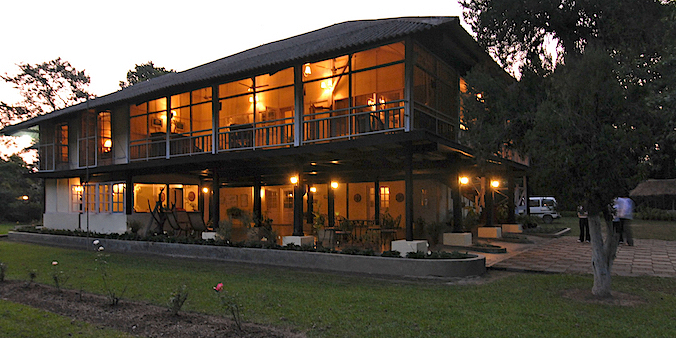
ANCIENT TEA BUNGALOWS
Tea Gardens of Assam
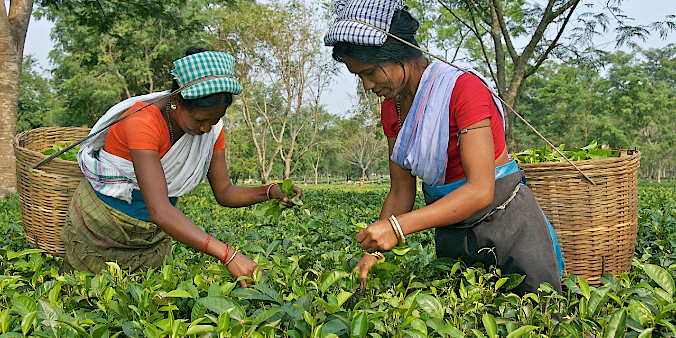
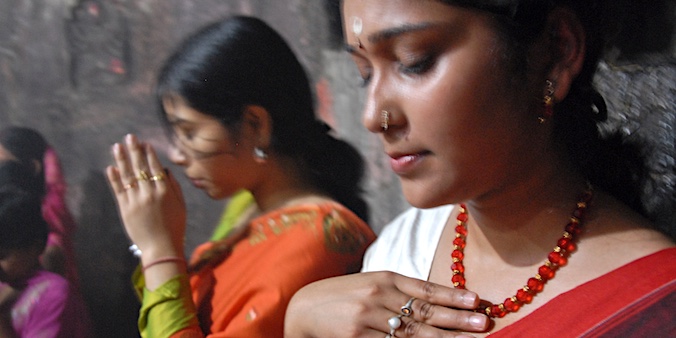
Sibsagar
Gibbon Sanctuary
Less than an hour’s drive from Jorhat is the Gibbon Sanctuary. This is a relatively small but beautiful protected area where the very rare Hoolock gibbons live, along with wild elephants and many species of forest birds. The Hoolock gibbons belongs to the great apes and only occurs in Assam and Bhutan. Chances to see the Hoolocks here, as they swing from branch to branch, are very good, especially early morning. You can visit the park on foot, accompanied by a park ranger. You’ll see many birds as well, and if you are lucky, a heard of wild elephants will cross your path!
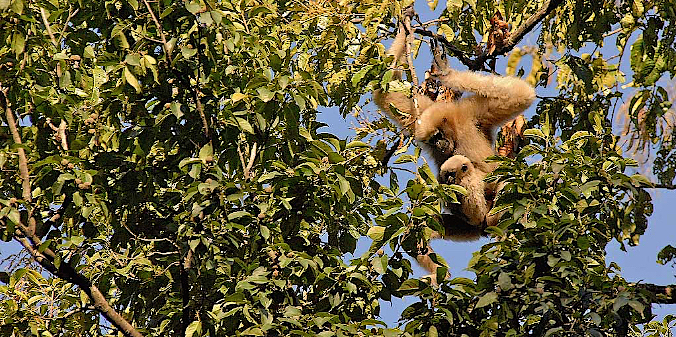
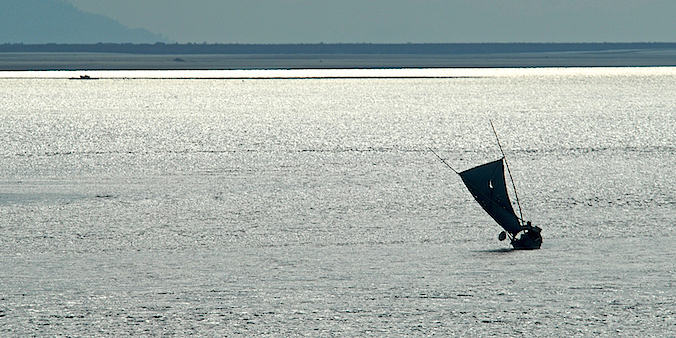
Brahmaputra CROSSING
The Brahmaputra is the boon and bane of Assam. It originates near holy Mt. Kailash in Southwest Tibet, then travels 1250km east along the Himalayan Range until it finally finds a gorge that provides a passage through the mountains to the south. Emerging on the eastern tip of the Assamese plains, it spreads its waters wide and far. Uninhibited by any civil engineering, it wildly braids, forming new channel and islands while abandoning others all the time. It brings water to the rice fields and fish to the nets, but commercial shipping has never taken off. Because being so wide and slow flowing, the Brahmaputra is very shallow. Wild elephants cross it regularly. Local ferries and tourist cruise boats are equipped with flat bottoms – to prevent capsizing – and often side propellers for getting unstuck as well.
Satras of Majuli island
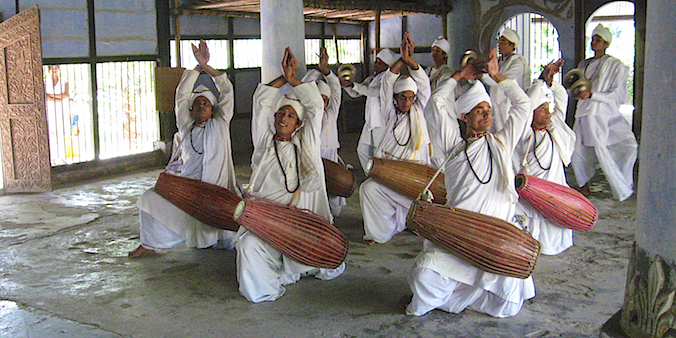
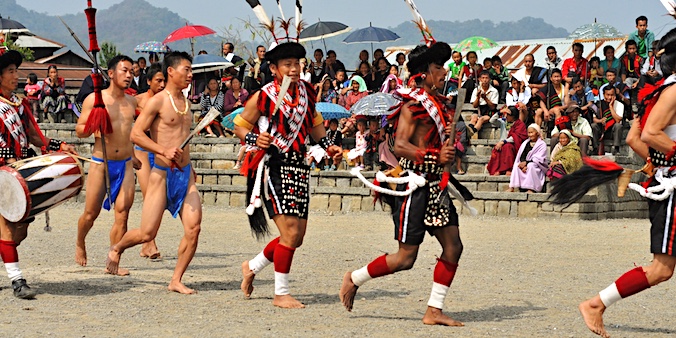
The Naga Culture
Kohima
Kohima, situated on wooded hilltops at about 1450m, is the capital of Nagaland. Visiting the city is worthwhile for several reasons. Its main claim to fame are the fierce battles which took place in 1944 during World War II between Japanese troups invading from Burma (Myanmar) and Allied British-Indian troops. The latter eventually gained the upper hand. The battle is often referred to as the ‘Stalingrad of the East,’ because Kohima is the point of the furthest Japanese advance into British India. Kohima’s well-kept War Cemetery with the graves of 1400 Allied soldiers is a sobering place. A very well appointed war museum in Kisama, outside Kohima, brings this defining point in Indian history to life. It is situated on the same grounds where each year in December the spectacular Hornbill Festival is held (see next highlight).
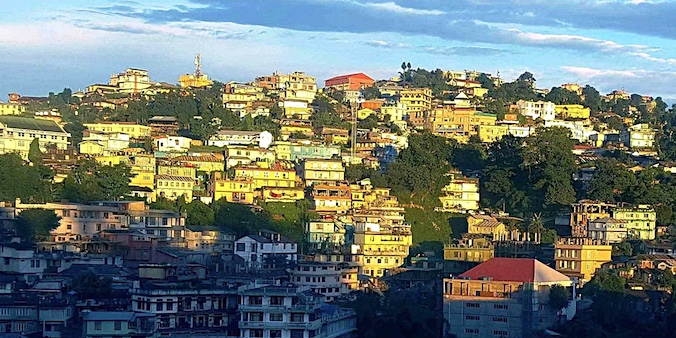
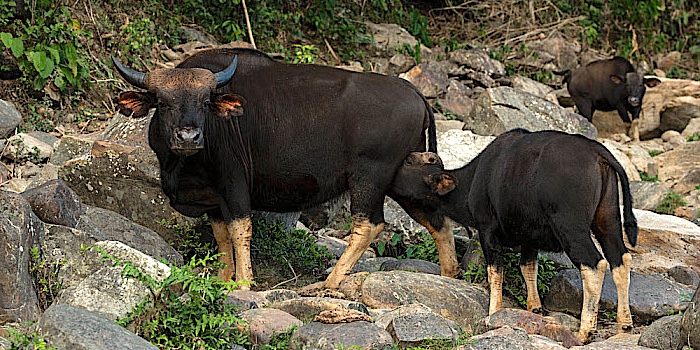
The Mithun
When traveling in Nagaland and Manipur, sooner or later, you will notice a strange kind of ‘cow’ by the side of the road. This is the mithun or gayal, a cross-breed between domesticated buffalo and wild gaur. The latter is a large and exceptionally muscular wild bovine that roams the last undisturbed forests of India. The gaur is a browser, adapted to foraging in the forest and eating leaves. Crossing the wild, hard to domesticate gaur with the easier to handle buffalos – that require grass, which is less available in forested areas – made a lot of sense for the forest-dwelling Idu. As the mithuns are mainly kept for meat, they can roam freely in the forest till it is time to face the music. The latter happens mainly in the form of sacrificing to the gods at one of the many festive occasions, such as religious festivals, marriages and funerals.
Khonoma
The small village of Khonoma is peculiar in many ways. Home to the fierse Angami tribals, it managed to repel attacks by the British in 1847 and 1879. Thus, its main claim to fame is that it was never conquered. These days, its main draw is the beautiful traditional looking village with its green terraced rice fields, herbal trees, flowers, pomelo trees, squash gourd vines and megaliths, against the back-drop of densely forested hills. The inhabitants of Khonoma predominantly live of agriculture and, like all Nagas, used to be passionate hunters. However, in a rare case of communal ecological awareness, in 2001 they gave up all hunting and declared an area of 2000 hectares near the village a conservation area. Now known as the Tragopan Sanctuary, bird watchers often visit this forest to spot the Blyth’s Tragopan (a rare pheasant) and 200 other bird species
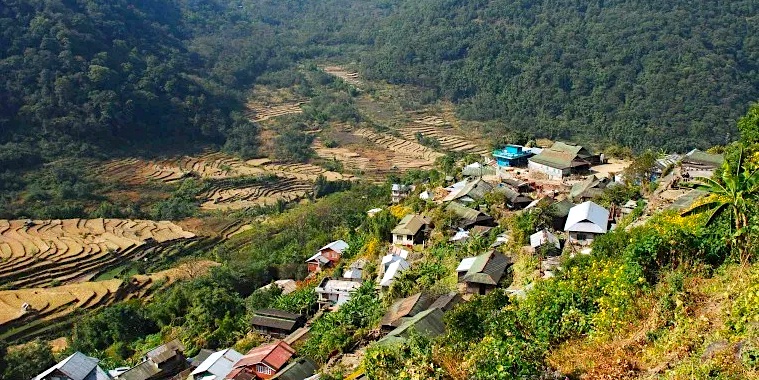
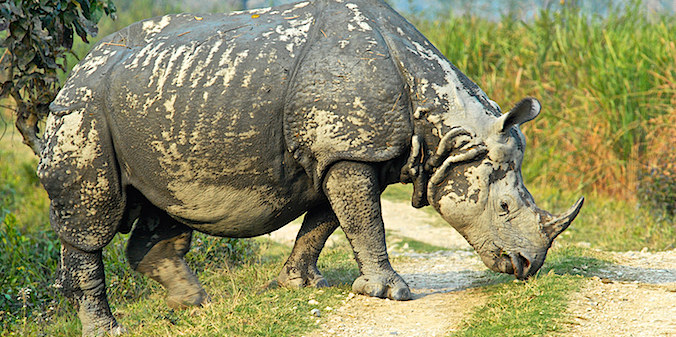
Kaziranga National Park
Guwahati
